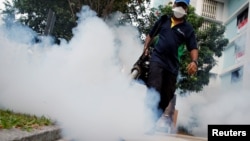The World Health Organization is increasingly concerned about the spread of the Zika virus in Southeast Asia.
The United Nations organization is worried the virus, which is carried by mosquitos, could affect local populations in the area.
Roderico Ofrin is the WHO regional emergencies director for Southeast Asia. He said countries need to carry out, in his words, “effective surveillance and reporting systems” to closely observe the disease’s spread.
“WHO is working with countries across the South East Asia region to continue to prevent, detect and respond to Zika virus transmission,” Ofrin said in an email to VOA.
He said the plan to deal with the disease places importance on limiting the spread of the disease and strengthening Zika virus and birth-defect surveillance.
He added that increasing the abilities of laboratories to test for the disease and increasing communication with communities were also important.
What is Zika?
Zika is blamed for causing the birth defect microcephaly, which can cause babies to be born with unusually small heads and possible brain damage.
So far, South America has suffered the most from the Zika virus. Brazil has reported hundreds of cases of microcephaly since the outbreak started there in 2015.
Now, the medical journal The Lancet Infectious Diseases has identified China, India, Indonesia, the Philippines and Thailand as high-risk countries.
The medical publication also said that Africa south of the Sahara Desert faced increased risk because of its historical ties with Brazil.
It warned that an estimated 2.6 billion people live in places where conditions for the spread of the virus exist. Pregnant women are most at risk.
Health officials say the virus also is spread through sexual contact, blood transfusions and from mother to child.
The Zika virus also has been linked to nerve damage that can result in weakened muscles and paralysis known as Guillain-Barre syndrome.
Zika in Southeast Asia
Southeast Asian governments have increased efforts to find evidence of the virus.
They have also sprayed chemicals in places where mosquitos breed.
However, Singapore has reported more than 240 cases. Malaysia and Thailand also have reported cases of infection, and the United States, Britain, Australia and Taiwan have given travel warnings for pregnant women.
Singapore’s Ministry of Health and National Environment Agency reported that the Zika virus affecting its community came from Asia. It said it did not come from Brazil.
Local news agencies in Thailand reported comments of a top official in the ministry of Public Health’s Department of Disease Control. The official said Zika has not become a serious outbreak in the country.
However, Thai Public Health Ministry officials say two women in the San Sai district of the city of Chiang Mai are being closely watched.
I'm Mario Ritter.
Ron Corben reported this story for VOA News. Mario Ritter adapted it for VOA Learning English. Kelly Jean Kelly was the editor.
______________________________________________________________
Words in This Story
surveillance –n. carefully watching something or someone
detect –v. to discover or notice the presence of something
transmission –n. medical, passing an infection from one to another








